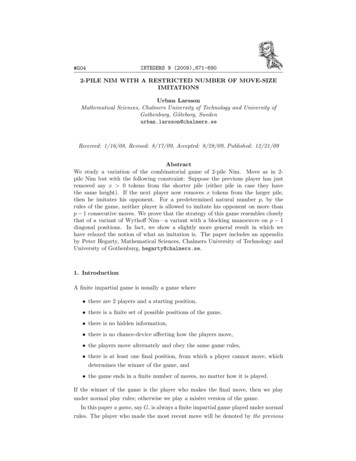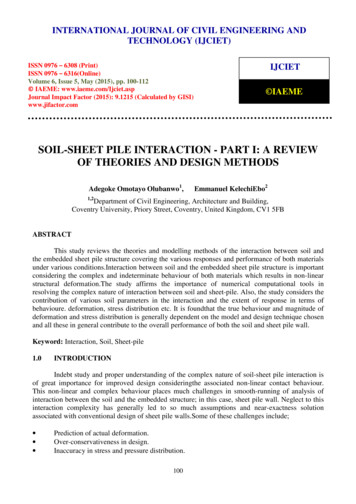
Transcription
INTERNATIONALJOURNALOF CIVILENGINEERINGInternationalJournal of Civil Engineeringand Technology(IJCIET),ISSN 0976 – 6308AND(Print),TECHNOLOGY(IJCIET)ISSN 0976 – 6316(Online), Volume6, Issue 5, May (2015),pp. 100-112 IAEMEISSN 0976 – 6308 (Print)ISSN 0976 – 6316(Online)Volume 6, Issue 5, May (2015), pp. 100-112 IAEME: www.iaeme.com/Ijciet.aspJournal Impact Factor (2015): 9.1215 (Calculated by GISI)www.jifactor.comIJCIET IAEMESOIL-SHEET PILE INTERACTION - PART I: A REVIEWOF THEORIES AND DESIGN METHODSAdegoke Omotayo Olubanwo1,Emmanuel KelechiEbo21,2Department of Civil Engineering, Architecture and Building,Coventry University, Priory Street, Coventry, United Kingdom, CV1 5FBABSTRACTThis study reviews the theories and modelling methods of the interaction between soil andthe embedded sheet pile structure covering the various responses and performance of both materialsunder various conditions.Interaction between soil and the embedded sheet pile structure is importantconsidering the complex and indeterminate behaviour of both materials which results in non-linearstructural deformation.The study affirms the importance of numerical computational tools inresolving the complex nature of interaction between soil and sheet-pile. Also, the study considers thecontribution of various soil parameters in the interaction and the extent of response in terms ofbehavioure. deformation, stress distribution etc. It is foundthat the true behaviour and magnitude ofdeformation and stress distribution is generally dependent on the model and design technique chosenand all these in general contribute to the overall performance of both the soil and sheet pile wall.Keyword: Interaction, Soil, Sheet-pile1.0INTRODUCTIONIndebt study and proper understanding of the complex nature of soil-sheet pile interaction isof great importance for improved design consideringthe associated non-linear contact behaviour.This non-linear and complex behaviour places much challenges in smooth-running of analysis ofinteraction between the soil and the embedded structure; in this case, sheet pile wall. Neglect to thisinteraction complexity has generally led to so much assumptions and near-exactness solutionassociated with conventional design of sheet pile walls.Some of these challenges include; Prediction of actual deformation.Over-conservativeness in design.Inaccuracy in stress and pressure distribution.100
International Journal of Civil Engineering and Technology (IJCIET), ISSN 0976 – 6308 (Print),ISSN 0976 – 6316(Online), Volume 6, Issue 5, May (2015), pp. 100-112 IAEMENeglect to non-linearity behavior of soil.Inconsistency in answer resulting to quandary and uncertainty.The need to proffer solution to these challenges in design of sheet pile and proper predictionof performance has been the area of interest among researchers (Ömer, 2012).However, varieties of conventional design methods have been in use till date. These includesthe fixed and free earth support method based on limiting equilibrium technique commonly found instandard codes such asEuroCode 7 (BS EN 1997), British Standard 8002 (BS 8002:1994) etc. withavailability of several factors to carter for this assumption; but then, the real physical situations arenot still well captured.In this respect, an improved and higher computational technique is undeniably required toensure a better design of sheet pile walls. The application of Finite Element Methods (FEM) instudying the interaction between soil and the sheet pile structure has been successfully employed insimilar situations in previous studies and researches (Ebo, 2014). The use of FEM in soil-structureinteraction studies have been in practice for years with great success starting from its first applicationby Clough (1969).The FEM is generally accepted as a convenient and well established technique for solvingcomplex engineering problems in civil, geotechnical, nuclear, mechanical engineering and othergeneral sciences. Over time, tremendous advancements have been made in the past 25 years both inmathematical formulations and generalization of FEM used to solve field problems in variousengineering analysis (Barkanov, 2001).The ability of the computational FEM to provide smooth tools to run comprehensive and allinclusive analysis of sheet pile performance in soil in which it is embedded has given acceptableresults of the interaction between both materials which includes stress distribution, sliding andoverturning effect, deformation, ground movements, dewatering due to construction activities etc.This has made the FEM a widely accepted approach for studyingsoil-sheet pile interaction (Ebo,2014).Hence, adequate interaction performance of the interface between soil and sheet pile requiresnovel integration of material properties modelling for both contacting materials, compatibility modeldevelopment, and robust interfacial interaction techniques (Olubanwo, 2013). This whole processentails the use of the proper material properties, on the right model development, and in the rightway.In this respect, the interaction between the two materials can be adequately accounted for,together with the unequivocal effectsof their non-linear behaviour. Further, accounting for thecontributions of various soil properties in FEM generally gives rise to improved result compare tothe theoretical methods / assumptions employed in the conventional design methods. The benefits ofthe improved method areenormous, ranging from reliability and cost-effectiveness which are theprimary objectives of engineering designs. Overall, numerical analysis readily provides alternativesto overcome difficult and time consuming analytical problems especially in geotechnical designs(MacDonald 2011).However, in spite of the enormous benefits accruing from application of this technique,proper application, indebt understanding of the FEM remains a challenge to design engineers, aswrong and inadequate understanding of the behaviour of the members may lead to deceitful resultswhich would result to error in design (Ebo, 2014).The overall aim of this research is to review various theories and modelling methods forstudying soil-pile interaction, with focus on the structural behaviour in terms of stress and straindistribution, deformation, stability and structural integrity of sheet pile wall. 101
International Journal of Civil Engineering and Technology (IJCIET), ISSN 0976 – 6308 (Print),ISSN 0976 – 6316(Online), Volume 6, Issue 5, May (2015), pp. 100-112 IAEME2.0REVIEW OF THEORIES AND MODELLING METHODSIn solving soil-structure interaction, application of a more pragmatic approach is ofimportance other than just ensuring separation of the soil and sheet pile wall at loading. Applicationof numerical analysis by use of FEM is undeniably the most advanced tool for carrying out analysisof the interaction between soil and sheet pile taking into account both their material and geometricnonlinearities (Jahromi, 2009).The applications of FEM have gained exponential rise in all engineering branches as well asin applied sciences; and in recent time, is undeniably the most used numerical method in both civiland geotechnical engineering and still gaining widespread popularity in other disciplines(Zienkiewicz and Taylor 1989).The present day applications of FEM in geotechnics are reported to have originated fromacademic researchers from Northern America and Europe. Research in this line of subject hasbeenon the increase over the years by several scholars (Richard 2003). Various model types are presentlyin use with previous successful application in study of soil-structure interaction. These are discussedbelow.2.1Model typesVarious kinds of soil – sheet pile models and techniques are presently in use, predominantly,the Mohr-Coulomb model and cap model with each of the models having advantages and associatedlimitations depending on the application (Mohammad et al., 2012).A brief comparison of various soil models which have been in existence and used for variousresearch works includes:2.1.1Mohr-Coulomb model:The Mohr-Coulomb failure criterion takes into consideration the effects of stresses on thestrength of soil when the equation (1) shown below is satisfied, i.e. the stress at any point in thematerial satisfies the equation;(1)represent the angle of friction and cohesion of the soil respectively.Where,The Mohr-Coulomb criterion in principal stress term is generally given by:(2)However, in the principal stress space, the Mohr-Coulomb yield criterion exists in the form of ahexagonal cone with an invariant form as shown in equation (3) and Figure 1.(3)102
International Journal of Civil Engineering and Technology (IJCIET), ISSN 0976 – 6308 (Print),ISSN 0976 – 6316(Online), Volume 6, Issue 5, May (2015), pp. 100-112 IAEMEFigure 2.1: Principal stress space of Mohr-Coulomb failure criteria (Beekman et al 2000)Figure 1 above shows the Mohr-Coulomb principle stress failure criteria with arepresentation of the various parameters arranged in space. Another function of interest is the plasticpotential form which takes the same form as the yield function and can be presented in the MohrCoulomb criterion by the replacement of the angle of friction, by dilatancy angle, in the yieldfunction; this is given by equation 4:(4)Where the dilatancy angle, is used to model the dilatative plastic volumetric incrementswhich comes into play in dense soils as exists in some of the soil strata. However, in real lifesituations, soil is incapable of sustaining much tensile stress, an act that can be stated by tension cutoff which can be represented with the functions , , and the maximum tensile stress, T given inequation 5 (Goldscheider 1984):(5)The Drucker-Prager model is a simplification of the Mohr-Coulomb model with areplacement of the hexagonal shape of the failure cone in Figure 1 with the simplified cone shown inFigure 2.2. The Drucker-Prager model shares same advantages and limitations with the MohrCoulomb model but is the most preferred due to its simplification and available in most recent FEpackages such as ANSYS (Zhao et al 2008).The Drucker-Prager plasticity is applicable to granular materials such as soils with its yieldsurface dependent on von Mises expression:(6)Where material yield, von Mises stress,103 material constant.
International Journal of Civil Engineering and Technology (IJCIET), ISSN 0976 – 6308 (Print),ISSN 0976 – 6316(Online), Volume 6, Issue 5, May (2015), pp. 100-112 IAEMEFigure 2.2: Drucker-Prager principle stress space (Leddin 2011)2.1.2 Cap modelThis is a form of soil constitutive model of the plasticity kind based on the concept ofcontinuum mechanics and critical state expressed in terms of three-dimensional stress state. It isexpressed in form of a dilative failure surface, , contractive yield cap surface, , each representedby the expressions:(7)represent the material parameters with the quantity ( ) used in materialWhere, , ,cohesive strength measurement.(8)Where, R is shape factor, the other parameters are as defined in Figure 2.3.Figure 2.3: Cap model yield surface (Desai and Siriwardane, 1984)3.0 CONVENTIONAL DESIGN THEORIES OF SHEET PILESSeveral theories are in existence for determination of pressure distribution used for the designof sheet pile. The most prominent of these theories includes the Coulomb and Rankine theories withboth made up of equations developed with fundamental assumptions that the retained soil ishomogenous, drained and cohesionless (Barnes, 2010).104
International Journal of Civil Engineering and Technology (IJCIET), ISSN 0976 – 6308 (Print),ISSN 0976 – 6316(Online), Volume 6, Issue 5, May (2015), pp. 100-112 IAEME3.1 Coulomb TheoryThe fundamental principle of the Coulomb’s theory is the creation of a failure surface of soilin a flat orientation and produces a slippage plane with appropriateness of the assumption preferablyapplicable to active cases with significant errors encountered when used for the passive case. Otherimportant hypothesis of the theory includes assumptions on the homogeneity of the soil, fulfilment ofthe Mohr-Coulomb failure criterion in the slippage plane, and the presence of soil angle of friction.Another important requirement of the method includes adequate rotation/yielding of the wall for fullengagement of all the shear strength, equilibrium of wedges at failure. A fundamental difference ofthe active and passive cases in this method includes formation of a high limit wedge to ensureengagement of the highest thrust while in the passive case, the wedge with provision ofminimum/low thrust is formed.Hence, with the above assumptions for soils in drained conditions, homogenous andcohesionless, linear earth pressure law for the active case is put into consideration using the relation;(9) horizontal pressure, unit weight of soil, Z height,Wherepressure represented with the equation; coefficient of active(10)Where angle of inclination of the wall with the horizontal. angle of friction of the soil. angle of inclination of the ground behind the wall. angle of friction between the soil and wall (Barnes 2010).A typical diagram of the Coulomb’s wedge analysis showing the various angles as inclined isshown in Figure3.1.Figure 3.1: Coulomb wedge analysis showing the various angles (Barnes, 2010)105
International Journal of Civil Engineering and Technology (IJCIET), ISSN 0976 – 6308 (Print),ISSN 0976 – 6316(Online), Volume 6, Issue 5, May (2015), pp. 100-112 IAEMEIt is evident from the Figure3.1 that the direction of the thrust is dependent on the angle ofinternal friction,with its magnitude calculated with consideration to equilibrium of forces atfailure.The Coulomb theory is known for its slight conservativeness and most appropriate for activecases and inappropriate for passive cases especially in situations of high and values, henceresulting to a critical condition for the sheet pile wall.3.2 Rankine theoryThe fundamental hypothesis of the Rankine theory is the condition of the soil still withinRankine limit state which is a stress state of plastic equilibrium with failure surfaces in twodirections. Here the passive case involves more volume of the soil wedge than in the active case asshown in the Figure3.2.Figure 3.2: Rankine failure wedges (a) Passive limit state (b) Active limit state (Alejo 2013)This takes place when the soil has attained the Mohr-Coulomb failure criterion representedwith the equation:(11)Where shear stress, c cohesive stress, normal stress, angle of friction.The failure criterion is hereby represented by Figure 3.3, showing the Mohr’s circle and theMohr-Coulomb failure envelope.Figure 3.3: Mohr Coulomb failure envelope (Whitelow, 2001)However, for the above criterion under the Rankine theory two frictional angles are requiredfor the soil to fail at active and passive limit states respectively, this is shown in Figure3.4.106
International Journal of Civil Engineering and Technology (IJCIET), ISSN 0976 – 6308 (Print),ISSN 0976 – 6316(Online), Volume 6, Issue 5, May (2015), pp. 100-112 IAEMEFigure 3.4: Mohr-Coulomb failure criterion (Alejo 2013)In Figure 3.4, for the active state, the horizontal stress and the vertical stressrepresentthe minor stress,andmajor stress, respectively. The active and passive stresses can becalculated with the following equations:(12)(13)In general, the Rankine theory is slightly conservative, adequate for active state andinadequate for passive state.4.0 SHEET PILE WALLS AND DESIGN METHODSSeveral design methods of sheet pile wall have been in existence either for cantilever oranchored sheet pile, with all establishing equilibrium of horizontal forces and moments so as toidentify the failure state and applying appropriate safety factors. The design methods are describedbriefly below.4.1 Cantilever WallsFor this case, the reaction force acts at the base of the wall and allows for stability where anincrease in embedment depth results to increased reaction in the opposite direction, but is not aguarantee for stability as shown in Figure 4.1.107
International Journal of Civil Engineering and Technology (IJCIET), ISSN 0976 – 6308 (Print),ISSN 0976 – 6316(Online), Volume 6, Issue 5, May (2015), pp. 100-112 IAEMEFigure 4.1: Net pressure for a cantilever wall (Alejo 2013)It is evident from Figure4.1 that stability depends on the adequacy of embedment below thedredge line. Three main methods for design of cantilevered walls include; full, simplified andgradual method.4.1.1Full methodThis involves the assumption that the active and passive limit states are reached at the backand in front of the wall respectively with a sudden jump in the earth pressure distribution as shown inFigure 4.2. The full method of design is popularly used in the UK.Figure 4.2: Earth pressure distribution for full method (Alejo 2013)4.1.2 Simplified methodThis involves a simplification of the full method due to its high complexity by replacing theearth pressure below the rotation point by a point load at point O as shown below:108
International Journal of Civil Engineering and Technology (IJCIET), ISSN 0976 – 6308 (Print),ISSN 0976 – 6316(Online), Volume 6, Issue 5, May (2015), pp. 100-112 IAEMEFigure 4.3: Simplified earth pressure (Alejo, 2013)The simplification generally results in a reduction in embedded depth d, from the oneobtained from the full method; this is corrected by a 20% to 40% increase of the d value i.e. usingembedded depth ranging between 1.2d and 1.4d (Das, 2004).4.1.3 Gradual methodKrey developed the method in 1932, later Bowles in 1988 reviewed the method which isbased on considering a transition zone where there is a change in the direction of the net earthpressure i.e. at the point of rotation and assumed to be linear (Škrabl, 2006). This method is mostlyused in U.S.A and is shown in Figure4.4.Figure 4.4: Net pressure for gradual method (Škrabl, 2006)4.2 Anchored wallEquilibrium can be actualized for the anchored wall type without putting the passive pressureat the bottom of the wall into consideration due tothe presence of anchor. Its main advantage overcantilever wall is possibility of embedded depth reduction which gives a more profitable structure;this is shown in Figure 4.5.109
International Journal of Civil Engineering and Technology (IJCIET), ISSN 0976 – 6308 (Print),ISSN 0976 – 6316(Online), Volume 6, Issue 5, May (2015), pp. 100-112 IAEMEFigure 4.5: Net pressure distribution in anchored walls (Alejo, 2013)The main methods used in design of anchored walls include; free and fixed earth supportmethods and are illustrated below (Das, 2004).4.2.1 Free earth support methodThis involves an assumed sufficiency of movements on the embedded region of the wall tomobilize both passive and active thrust at the front and behind the wall respectively with the bottomfree to move. The embedment depth is obtained by using equilibrium satisfaction for both the activeand passive pressures and anchor force (Alejo 2013); this is shown in Figure 4.6.Figure 4.6: Pressure distribution for free earth support method (Das, 2004)4.2.2 Fixed earth support methodFor this method, the earth pressure distribution takes the form of a cantilever with the wallexhibiting the behaviour of a built-in beam exposed to bending moments and requires determiningthe point of zero net pressure (Das 2004). This is shown in Figure4.7.110
International Journal of Civil Engineering and Technology (IJCIET), ISSN 0976 – 6308 (Print),ISSN 0976 – 6316(Online), Volume 6, Issue 5, May (2015), pp. 100-112 IAEMEFigure 4.7: Earth pressure distribution for fixed earth support method(Alejo, 2013)The above methods of sheet-pile design are currently in use and are applicable to the relevantstandards such as the EuroCode 7 (BS EN 1997) and British Standard 8002 (BS 8002:1994) whichuse the serviceability and ultimate limit state procedure and consideration with factors for design ofvarious site and material properties and conditions.However, no firm guideline exists for determiningacceptable deflection of a sheet pile wall, but deflection ranging from 25mm to 127mm is generallyacceptable (Techical supplement 14R 2007).5.0 CONCLUSIONSAs have been reviewed on this paper, the following conclusions can be drawn;The true behaviour and magnitude of deformation, stress distribution etc. is dependent onmodel and design technique chosen and all these in general contribute to the overallperformance of both the soil and sheet pile wall.No firm guideline exists currently in relevant design standards of sheet-piles for determiningthe acceptable deflection of a sheet pile wall.Much of the drawbacks associated with conventional analytical and design methods can beovercome using computational FEM of analysis / design by ensuring proper model creation,assigning sufficient material properties, choosing the right failure model, and ensuring that thesolution captures the full geometric and material nonlinearities of the deformed configuration.REFERENCES1.2.3.4.5.Alejo, G. T. (2013) Numerical analysis of cantilever and anchored sheet pile walls at failureand comparison with classical methods. Unpublished dissertation. Barcelona: Escola deCamins.Barkanov, E. (2001) Introduction to the Finite Element Method. Latvia: Riga TechnicalUniversityBarnes, G. (2010) Soil Mechanics – Principles and Practice.2nd edn. England: PalgraveMacmillanBeekman, F., Badsi, M., and Wees, D. V. (2000) Faulting, Fracturing and In-Situ StressPrediction in the Ahnet Basin, Algeria - A Finite Element Approach [online] available from http://www.falw.vu/ beef/research/papers/ahnet/tp/ahnet.htm [10 August 2014]Clough, G. W. (1969) Finite element analysis of soil-structure interactions in U-frame locks.Unpublished PhD thesis. Berkeley: University of California111
International Journal of Civil Engineering and Technology (IJCIET), ISSN 0976 – 6308 (Print),ISSN 0976 – 6316(Online), Volume 6, Issue 5, May (2015), pp. 100-112 2.23.24.Das, B. M. (2004) Principles of foundation engineering. 5th edn. U.S.A: Brooks/Colepublishing companyDesai, C.S., and Siriwardane, H. J. (1984) Constitutive laws for engineering materials.Englewood Cliffs: Prentice-Hall Inc.Ebo, E. K. (2014) Soil – sheet pile interaction. Unpublished dissertation. Coventry: CoventryUniversity Coventry United KingdomGoldscheider, M. (1984) “True triaxial tests on dense sands”.Constitutive relations for soils.Rotterdam: BalkemaJahromi, H. Z. Z. (2009) Partitioned Analysis of Nonlinear Soil-Structure Interaction.Unpublished PhD thesis. London: University of London and Imperial College LondonLeddin, M. (2011) Structural mechanics simulation (CSM using finite element analysis). UK:ANSYS UKMacDonald, B.J. (2011) Practical stress analysis with finite elements.2nd edn. Dublin:Glasnevin publishingMohammad, M. J., Syed H. G., Mohammad, R. J., Alistair B., Mir, K. Z. A. and Reza, M.,(2012) Using Finite Element method for Pile-Soil Interface (through PLAXIS and ANSYS).Academic Journal of Civil Engineering and Construction Technology, University CollegeCork, Cork, Ireland, Mazandaran University, Sari Iran Jahad, Daneshgahi of Tarbiatmodaresuniversity, Tehran, Iran Vol. 3(10), pp. 256-272, November 2012Ömer B. P.E., (2012) Lateral Earth Pressure Coefficients for Anchored Sheet Pile Walls International Journal of Geomechanics ASCE, September/October 2012Richard, I. W. (2003) The Application Of Finite Element Analysis to the Design ofEmbedded Retaining Walls. Unpublished PhD thesis. Surrey: University of SurreyŠkrabl, S. (2006) “Interactional approach of cantilever pile walls analysis”.Slovenica:ActaGeotechnicaSlovenica 2006/1Techical supplement 14R (2007) Design and Use of Sheet Pile Walls in Stream Restorationand Stabilization Projects [online] available from nt.aspx?content 17828.wba [10August 2014]Whitelow, R. (2001) Basic soil mechanics.4th edition. London: Pearson Educational LtdZhao, M. H., Liu D., Zhang L., Jiang, C. (2008) 3D finite element analysis on pile-soilinteraction of passive pile group. Institute of Geotechnical Engineering, Hunan University,Changsha 410082, ChinaZienkiewicz, O. C. and Taylor, R. L. (1989) the Finite Element Method. 4th edition, Volume1. Maidenhead: McGraw-HillKavitha P. E., Dr. Beena K. S. and Dr. Narayanan K. P, “Analytical Study on Soil-PileInteraction Effect In The Variation of Natural Frequency of A Single Pile” InternationalJournal of Civil Engineering & Technology (IJCIET), Volume 5, Issue 12, 2014, pp. 226 229, ISSN Print: 0976 – 6308, ISSN Online: 0976 – 6316.Nagendra Prasad.K, Manohara Reddy.R, Chandra.B and Harsha Vardhan Reddy.M,“Compression Behaviour of Natural Soils” International Journal of Civil Engineering &Technology (IJCIET), Volume 4, Issue 3, 2013, pp. 80 - 91, ISSN Print: 0976 – 6308, ISSNOnline: 0976 – 6316.Abeer Sabri Bshara, Er. Y. K .Bind and Prabhat Kumar Sinha, “Effect of Stone Dust onGeotechnical Properties of Poor Soil” International Journal of Civil Engineering &Technology (IJCIET), Volume 5, Issue 4, 2014, pp. 37 - 47, ISSN Print: 0976 – 6308, ISSNOnline: 0976 – 6316.112
interaction between the soil and the embedded structure; in this case, sheet pile wall. Neglect to this interaction complexity has generally led to so much assumptions and near-exactness solution associated with conventional design of sheet pile walls.Some of these challenges include; Prediction of actual deformation.
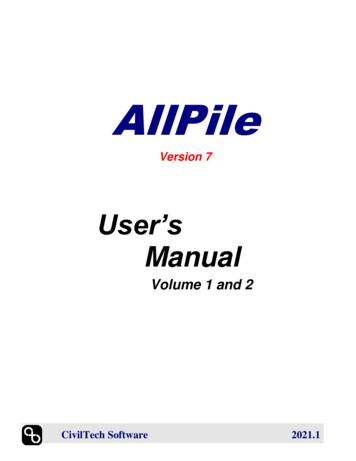
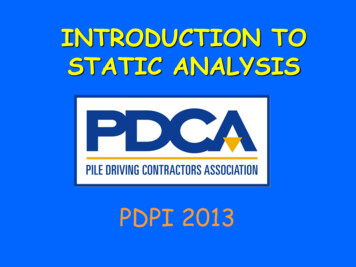



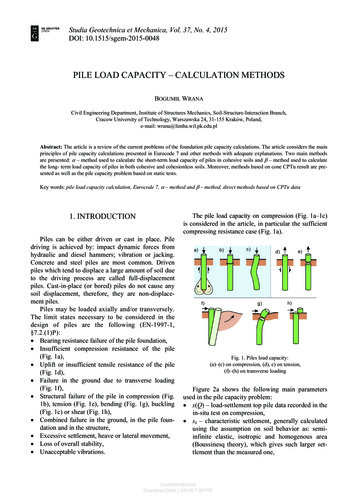
![Pile Foundation Design[1] - ITD](/img/29/pilefoundationdesign.jpg)
